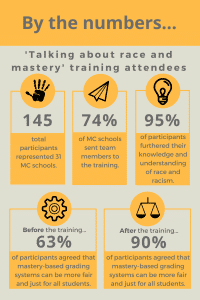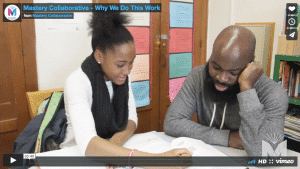The Mission and the Message
CompetencyWorks Blog

How we found our ‘why’—and how we’ve used it to create urgency and
common purpose in our community’s quest for greater educational equity.
By Julianna Charles Brown, Jeremy Chan-Kraushar, Joy Nolan, and Patrick Williamson of Mastery Collaborative, a program of New York City Department of Education’s Office of Postsecondary Readiness
***
Any school that has embarked on shifting to mastery-based teaching and learning can tell you that messaging and mission are vital to this complex endeavor—which affects every aspect of teaching, learning, assessment, and school culture. A clear and powerful mission inspires all stakeholders to connect to and invest in the work more deeply and authentically. Without a clear mission, the work of a school or any organization is susceptible to a lack of focus, resistance from within, and confusion in implementation. As a leader, it’s hard to call the shots without a guiding mission. As a member of a community, it is necessary to have clarity about what’s happening and why.
A strong mission statement articulates the ‘why’ that powers the work. Great missions connect the day-to-day operations of an organization with a desired larger impact, and ideally, all stakeholders can contribute to its creation. Once a strong mission is developed, it should then become fundamental to the way you speak about your work. When taking on large and complex endeavors—like transitioning away from traditional education to mastery-based models—the ‘why’ must be meaningful and inspiring enough to justify the sustained focus required to accomplish multidimensional school change over several years’ time. In working with our school partners, we help to co-create communications materials and provide training that supports school leaders and staff in talking to parents, students, community partners and others about their school’s mastery-based systems. We also model the kind of mission-driven communications that practitioners can use to think about their own communications approach.
How we found our ‘why’
We started the Mastery Collaborative (MC) in 2015-16, to form a community for dozens of schools across New York City that were implementing mastery-based shifts in relative isolation. We dedicated that first year to creating a lively community of practice with and for member schools, and learning from them about mastery implementation models around the city. While visiting schools, we noticed a distinct feel in more advanced competency-based schools. There was positive energy in the air, and there was a shift in the adult/student power dynamic—as one school leader put it, “Students here have lots of choice and freedom, and lots of responsibility to their own learning and to our school community.”
In these schools, students regularly described what they were learning and why and were able to pinpoint how they could improve; we were seeing the self-confidence and assurance of students who valued school and felt they belong there, who were were empowered to own their learning—and we were seeing educators who believe in the young people they work with, and who understand that power is not a zero-sum game. Helping students find their power as learners only makes a class more compelling and powerful for them. Giving up a position as a lecturer at the front of the room only means finding more power as a facilitator of students’ learning. By the conclusion of MC year one, a hypothesis was forming: that there was a unique connection between mastery-based shifts, culturally responsive practices, and equity. To share out these ideas, we made program videos such as Why make the shift to mastery-based learning? and How does mastery transform school for students and teachers?

We began our second year knowing we had to explore the connection between mastery, cultural responsiveness, and equity. The MC community of schools eagerly joined in, digging deeper into the why of mastery learning, and the philosophy that both demands and powers these complex shifts.
 In year 2, we asked each MC member school to create a goal for infusing CRE into their mastery-based practices. Additionally, we asked everyone in our community of educators to attend an anti-bias training called “Talking about race and mastery.” We set up a series of dates for small sessions of this training, hoping everyone could find a time to come together to explore the intersections of race and schooling. We also facilitated a working group that met online and in person across the year to explore the intersection of mastery and CRE. This group developed the Equity Snapshot, which beings to detail the ways that CRE and mastery intersect.
In year 2, we asked each MC member school to create a goal for infusing CRE into their mastery-based practices. Additionally, we asked everyone in our community of educators to attend an anti-bias training called “Talking about race and mastery.” We set up a series of dates for small sessions of this training, hoping everyone could find a time to come together to explore the intersections of race and schooling. We also facilitated a working group that met online and in person across the year to explore the intersection of mastery and CRE. This group developed the Equity Snapshot, which beings to detail the ways that CRE and mastery intersect.
Our school-based community members contributed reactions, opinions, and ideas around our mastery-and-equity hypothesis. At trainings, gatherings, and site visits, we invited and made time for conversations and written input about the relationships between mastery, cultural responsiveness, and equity. We made a practice of synthesizing, incorporating, and sharing out practitioners’ ideas about philosophy and practices.
We learned so much from and with educators at mastery-based schools across the city, who delved into exploring CRE and mastery: administrators, schools counselors, and teachers implementing mastery in our schools. In our anti-bias trainings and working group sessions, certain elements of mastery rose to the top as most closely aligned to academic research on culturally responsive education:
- Transparency: path to success is clear and learning outcomes are relevant to students’ lives and interests. Shared criteria reduce opportunity for implicit bias.
- Changing power dynamics: facilitation shifts refocus the roles of students and teachers to include flexible pacing, inquiry-based, collaborative approach to learning. Student drive their own learning, and teachers coach them.
- Positive learning identity: growth mindset and active learning build agency and affirm students’ identities as learners (academics, race, ethnicity, gender, sexual orientation, etc.)
These findings helped to explain the distinct student-centered culture we noticed in Year 1 in the longest-practicing mastery schools—and contributes to the why for the complex work of creating effective mastery systems that are culturally responsive. Our Year 2 exploration of CRE and mastery led us toward the development of this community mission:

Armed with this clear and powerful new mission, our communication strategy came into clearer focus. Now it is easier to build coalitions with others who value this work. Our mission has created a sense of urgency and a through-line for all we do.
Spreading the urgency of our message
One example of how we tied together our evolving understanding of the ability of mastery to increase equity in schools was the creation of a program video, ‘Why We Do The Work.’
 This video highlights the voices of students, teachers, administrators, and experts from the field in hopes of connecting these dots for a wider audience. Students and teachers reflecting on past experiences in traditional settings and provides context for shifting to a more culturally responsive approach to mastery-based teaching and learning.
This video highlights the voices of students, teachers, administrators, and experts from the field in hopes of connecting these dots for a wider audience. Students and teachers reflecting on past experiences in traditional settings and provides context for shifting to a more culturally responsive approach to mastery-based teaching and learning.
The video lays out our organization’s vision through quotes from Chris Sturgis of CompetencyWorks and members of the Mastery Collaborative team. Constructing a short video to translate the urgency of the work was difficult work, and was possible only after our yearlong process of inviting co-creation of our mission stance across our community. We hope that the short video can assist in crystallizing our focus and mission for all stakeholders, and can be used to galvanize the urgency this work for the MC community and beyond.
By popular demand, we also started the yearly MC Summer Institute this past July with a Day 1 deep dive on CRE and mastery. Here are the resources from that day.
Aligning your mission to your message
The shift to mastery-based education is complex. It requires shared commitment to “unlearn” old ideas, approaches, and systems—and to embark on a long-term, coordinated effort with a multitude of stakeholders. A mission that is clear and aspirational provides common context, clear direction, and justification for sustained effort across a school community and across several years of change management. A mission is a filter for everything your organization or school does or might do, and a rudder to keep the course set in the best direction. So how do you create a mission that will win hearts and minds, and stand the test of time?
Here are some things practitioners can keep in mind when creating or iterating on their school’s mission statement:
- Co-create your mission statement with valued stakeholders, inviting the input and expertise of everyone in the group, when engaging in any complex philosophical change. Hear out their reservations and concerns, as well as their enthusiasm and willingness.
- Create a mission your whole community can buy into, but that can also be tailored to different audiences. Each member of your school community has a different role in pushing the work forward, and a strong shared mission will keep those efforts cohesive.
- Incorporate a range of voices and perspectives from across your organization as you communicate your mission to new or larger audiences. This helps to communicate the buy-in your mission has, as well as how it matters to and affects various stakeholders.
Across the MC community, there is a great urgency to our work—so the way that we talk about our mission is of utmost importance. Across our community, we seek to create to conditions for students to understand and own their trajectory as learners, and to experience the motivation and joy in learning for the thrill of learning itself. We want our students to feel that their identities are seen, understood, and valued within their schools. We need to be transparent with students in regards to what they need to improve on to achieve success in any given classroom. We need to build system capacity and write policies to support this work. We need to keep seeking new allies and partners in this work, to better serve those young people who stand to benefit most, to the extent that we get it right. Your organization may share some of these urgencies, or may have other important work to accomplish. How you message your mission will partly determine your degree of success.